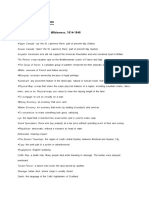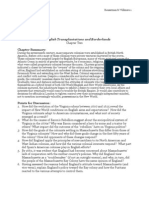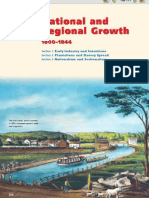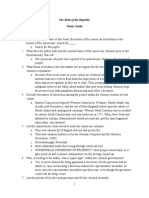Socials 10 CH 1 Answer Key
Socials 10 CH 1 Answer Key
Uploaded by
Henry ChadwickCopyright:
Available Formats
Socials 10 CH 1 Answer Key
Socials 10 CH 1 Answer Key
Uploaded by
Henry ChadwickOriginal Description:
Original Title
Copyright
Available Formats
Share this document
Did you find this document useful?
Is this content inappropriate?
Copyright:
Available Formats
Socials 10 CH 1 Answer Key
Socials 10 CH 1 Answer Key
Uploaded by
Henry ChadwickCopyright:
Available Formats
Chapter 1
Name:
Canada: The Land
HWSS Socials
1.
Interpretation Questions
Name the six colonies of British North America in 1825
Upper Canada, Lower Canada, New Brunswick, Nova Scotia, P.E.I.,Newfoundland
2.
What name was given to the land owned by the Hudsons Bay Company?
Ruperts land
3.
What was present-day British Columbia called and who controlled it?
Oregon Territory, controlled by both England and the USA
4.
What was meant by W.L.M. Kings comment Canada has too much geography?
Canada hard to develop, large bodies of water, rivers, etc. mountains, hard to move and to
populate
5.
Why do most Canadians live close to the border?
Trade, the Great Lakes and the St. Lawrence Seaway,
close to the large populations
6.
Where is Canada situated in relation to the equator and the prime meridian? (Roughly, in degrees of longitude and
latitude)
7.
Describe the Canadian Shield.
Ancient granite, around Hudson Bay, few farms, not much soil, some forests
8.
What is Sudbury, Ontario famous for? Big
9.
What is the area around Toronto called?
Nickel, mineral wealth
Industrial heartland
The Land of Yesterday: pages 14 16
10. What economic activity attracted settlers to: #1
a. Upper Canada: relatively
b. Lower Canada: farming,
c.
inexpensive farmland, fur trade
fur trade
The Maritime Colonies: well
settled, fish, timber, trade with Britain
11. Which two companies controlled the fur trade in the 18 th century?
12. What kind of people worked in the fur trade?
HBC and North West Company #2
Mtis and the French #3
13. Which fur-bearing animal proved to be the most profitable to the fur traders?
Otter or beaver #4
14. How did the fur traders goals conflict with the settlers goals?
Prevented settlement, harmed the fur trade,
couldnt farm #5
Upper Canada: pages 16 22
15. How long did it take for a family to clear an average farm?
20+ years, 1 ha/year #6
16. Why were most families required to mortgage their crops for several years?
To pay expenses, couldnt grow
large crops till land was cleared, took a long time to pay start up expenses #7
17. Explain how the barter economy works.
when 2 or people trade goods, no money passing hands,
equal value goods traded #8
18. How did the settlers make the most use of raw materials on their land? #9
Nothing went to waste, used sold traded, trees were cut for lumber, debris burned to make
ash potash and lye which was turned into fertilizer and soap.
19. Who were the family compact and why were they so powerful? How did they get their name? #10
British ruling elite, had lots of money and controlled the government, most were family
members {all related}
20. Explain how life in Upper Canada had a way of leveling people. #11
All had to work on the farm, had to help each other to survive
21. What was the name of the ruling elite in Upper Canada and what did they believe in? #12
Family Compact, success for the rich and that the upper class/elite should rule
22. What kind of conditions did settlers from Europe expect to find in Upper Canada? #13
Good transportation, good and accessible cheap land, cleared land, easy access to trade and
supplies
23. What reality did they discover when they arrived? #14
The opposite, poor transportation, hard life
24. Explain the role of land speculators in Upper Canada and how much land they owned. Bought
high #15
land cheap, sold
25. How much land was set aside for the Crown and Clergy Reserves?
Why did this create so many problems for the settlers?
2/7, 1/7th each #16
Land was blocked, no trespassing, no roads
through, best land taken
26. Which group did the British government feel could best control the land in Upper Canada?
English aristocrats, Family Compact #17
27. In 1791, who held the power in the government? What power did he have? Why wasnt this system responsible or
representative? How is that system different than the system we have now?
Simcoe, unlimited oligarchy,
he didnt answer to anyone, couldnt remove him from office. Responsible now #18
The Immigrant Experience: Pages 23 - 32
28. Explain why the boats that poor British immigrants traveled to Canada in were called Coffin ships. #19
Many died during trip over from England or else they were ill when they arrived
29. In what year did most immigrants come to Canada from Great Britain?
30. Where did most of the immigrants come from?Great
1847 #20
Britain #21
31. What problem was caused by the rapid immigration into Upper and Lower Canada? What might have been the
outcome of this problem? Disease,
massive amount of people, not enough land or infrastructure
high crime, not enough employment #22
32. Which religious groups sheltered Black Americans along the Underground Railroad? Quakers
and Methodists
#23
33. What was their belief about slavery? It
was a sin against humanity #24
34. In which areas of Canada did most former slaves find acceptance and settle?
Upper Canada and the
Maritimes #25
35. Why were unmarried women pitied in pioneer society?
Had to rely on relatives, friends, very hard life #26
36. How did pioneer life break down social barriers to women?
All worked together, farmed together and did
house work together to survive. #27
37. Describe a womans typical duties and obligations on a farm.
of the family, #28
Colonial government and the Need for Reform, Pages 33-36
Housework, long hours, farming, taking care
1. Define the following terms: #29
a. Representative government: elected
b. Responsible government:
c.
Oligarchy: few
by people, created laws on their behalf
executive council is responsible to Leg. assembly
govt officials, tend to be rich and influential men
2. What kind of governments are representative?
Democratic #30
3. Explain what is meant by rep by pop {page 78}. Representation
based on number of people, equal
number of members for a set number of voters #31
4. Why did the British appointed governor rule for the oligarchy?
5. Name two aspects of the Constitutional Act of 1791.
Aristocrat, friends with those in power #32
1. divided Upper and Lower Canada, 2. gave the
colony an elected law making assembly #33
6. Why were there problems with the system of government after 1791?
Power held by govt and appointed
council not with people, they could veto any law #34
7. Who could vote at this time? Male
landowners #35
8. What did the Legislative Assembly want the government to do?
Spend $ on projects to help ordinary
people #36
9. What did the Executive and Legislative councils want the government to do?
Help the business class, better
roads and infrastructure, ignore the problems of the land speculators #37
10. Why were the members of the Assembly always frustrated?
Didnt agree with the govt #38
11. Why did settlers in Upper Canada have such difficulty establishing farms?
2/7 was land reserve, poor govt
policies #39
12. Why was Robert Gourlay arrested and sent out of the country {deported}?
13. Who took his place as the leading reformer? William
Spoke out against the govt, #40
Lyon Mackenzie #41
14. How did this argumentative Scotsmans view about government become so well known?
Published articles against the govt, member of the Legislative Assembly #42
15. What kind of government did he advocate for as the leader of the reform movement in 1828? democratic
16. Elections in the 1830s had no secret ballots. Describe the typical election process.
#43
Rally, threatened voters
with violence, bribed with money or alcohol #44
17. Today, what guarantees Canadians that they can protest against the government?
Charter of rights, freedom to
vote #45
18. Read Page 36 and answer questions 1, 2 and 4.
1
2
4
Stirrings in Lower Canada, Pages 37 43
1.
Name the three things that influenced French-Canadiens politically: #46
i. Language
ii. cultural roots
iii. ideology
2.
Who made up the oligarchy in Lower Canada? Merchants,
ex-army officers, elite Chateau Clique #47
3.
What name was given to this oligarchy?
4.
Who did they maintain ties with and why?
5.
Why did Lower Canada not experience the problems associated with land that plagued Upper Canada?
Chateau Clique #48
church and wealthy French Canadian landowners #49
Settled for a longer period of time #50
6.
What was the population of Lower Canada in 1820 and what percentage were Anglophones?
~420 000, 20% were Anglophones {~80000} #51
7.
What two events led French people to believe that their way of life was under attack?
Wanted to make English the official language, wanted to join Upper and Lower Canada ,
French would then be the minority #52
8.
Why did the Canadiens suspect that Britain was trying to solve the French problem with their immigration policies?
Explain their suspicions clearly. Wanted
to change the seigneural system, into a Britain freehold
system, the French would then be the minority #53
9.
Explain why the reformers in Lower Canada were frustrated with the Chateau Clique? Change
the old
seigneural system, reduce power of chateau clique, felt discriminated politically and
economically, didnt want to give up power #54
10. Explain why the French farmers were frustrated with the British government.
Raise land taxes, leave business revenue untouched #55
11. Who was the leader of the radical reformers in Lower Canada and what three issues did he focus on?
Louis
Joseph Papineau, a. discrimination against the French, b. unequal taxation, c. lack of power
over govt #56
12. What two things did the reform leaders want most?
A. assembly wanted control of the govt budget, B.
wanted a more American style republic #57
13. How did Governor Craig deal with the French problem in Lower Canada?
Arrested those that criticized the
govt, brought in soldiers to intimidate the French population. #58
14. Why did the French not support the proposal to unite Upper and Lower Canada in 1822?
Demanded a complete
change in the way the colony was governed, French would be the minority #59
15. Explain why Papineau and the Patriotes openly rebelled against the government in 1837?
Shared the same views on govt and economy, similar ideology #60
16. Explain the Seigneurial system.
A form of feudalism, one person owns the land and portions of it,
new owner must work a certain number of days for the Seigneur, give crops and wood to
him, the seigneur was responsible for building roads, church, mill and boundaries only
French used this #61
17. Who had the most power in Lower Canada?
Chateau Clique English bankers and ex-military #62
18. Discuss the accomplishments of Louis Joseph Papineau #63
Petition against the union; part of the
committee that wrote the 92 resolutions; leader of the Patriotes
19. What 3 issues became the focus of reformers in Lower Canada? #64
discrimination against the French, unequal taxation, lack of power within the government
20. How were the ruling classes favoured economically?
Political leaders, government officials,#65
21. How did Britain exacerbate the French/English problem in 1810? In 1822?
Proposal to unite Upper and
Lower Canada, French would be a minority and force English upon the united colonies as
well as the British would be the ruling majority #66
22. Why did MacKenzie and Papineau think armed attacks on the government was the only solution to their problems.
The government would not be reformed from within, they saw no other way to gain a voice
in the government and to remove the Chateau Clique from power #67
23. What was the outcome of the attacks? Why?
die easily defeated #68
Rebels lost, poorly organised and didnt want to fight to
24. What happened to the majority of the rebels?
Leaders were publicly hanged, the others - some
flogged, others sentenced to death while others were transported to Bermuda for 7 years
slave labour {many died in transport or from work} #69
25. Explain what happened in relation to Lord Durham and Lord Syndenhams actions {how did the French and English feel
about their actions/rules}?
#70
You might also like
- Grade 9 Social Studies Textbook BC CrossroadsDocument13 pagesGrade 9 Social Studies Textbook BC Crossroadsabby100% (1)
- Orishas of Trinidad: African Spirituality Beliefs and Practices, #7From EverandOrishas of Trinidad: African Spirituality Beliefs and Practices, #7No ratings yet
- Gilded Age - Viewing QuestionsDocument6 pagesGilded Age - Viewing QuestionsAmy GibbonsNo ratings yet
- UntitledDocument34 pagesUntitledGriffin Andreychuk100% (1)
- Grade 11 Canadian History Exam ReviewDocument7 pagesGrade 11 Canadian History Exam Reviewapi-223081096No ratings yet
- Socials 10 Exam NotesDocument30 pagesSocials 10 Exam NotesAlisha DavisNo ratings yet
- Chapter 6 PowerpointDocument26 pagesChapter 6 Powerpointapi-264452511No ratings yet
- Exam Review QUESTIONS HistoryDocument17 pagesExam Review QUESTIONS HistoryGurjind Dhaliwal100% (1)
- 7SS Final Exam Review KEYDocument12 pages7SS Final Exam Review KEYNathaniel K9907No ratings yet
- Exam Review - Part OneDocument6 pagesExam Review - Part Onepakak14No ratings yet
- HISTORY EXAM REVIEWDocument8 pagesHISTORY EXAM REVIEWlananh201108No ratings yet
- Social Studies Final Exam Review Key 2015Document33 pagesSocial Studies Final Exam Review Key 2015api-193600542No ratings yet
- First Permanent English SettlementDocument3 pagesFirst Permanent English SettlementAnita JaipaulNo ratings yet
- Epenisa 1Document8 pagesEpenisa 1api-316852165No ratings yet
- The Colonial Era - Spring 2014Document41 pagesThe Colonial Era - Spring 2014api-261097177No ratings yet
- Canada Before 1914Document29 pagesCanada Before 1914dollfour4No ratings yet
- Unit 1 APUSH Test AnswersDocument5 pagesUnit 1 APUSH Test AnswersKelley O'HaraNo ratings yet
- Unit 1 Review Guide-Answers - Docx - US HistoryDocument3 pagesUnit 1 Review Guide-Answers - Docx - US HistorymelissagfreyNo ratings yet
- Civil War Parts 1 & 2 Study Guide and AnswersDocument4 pagesCivil War Parts 1 & 2 Study Guide and AnswersbuddylembeckNo ratings yet
- Chapter 3 Essays and Short AnswerDocument23 pagesChapter 3 Essays and Short AnswerJoseph BurnettNo ratings yet
- Summary of Alan Greenspan & Adrian Wooldridge's Capitalism in AmericaFrom EverandSummary of Alan Greenspan & Adrian Wooldridge's Capitalism in AmericaNo ratings yet
- Questions To AddressDocument7 pagesQuestions To AddressAlexa SchleinNo ratings yet
- Chapter 2 - Trans Plantations & BorderlandsDocument6 pagesChapter 2 - Trans Plantations & BorderlandsDavid W.100% (2)
- Booklet 1Document15 pagesBooklet 1Vikranth DNo ratings yet
- RebelsDocument2 pagesRebelsapi-193600542No ratings yet
- The CanadiansDocument3 pagesThe Canadiansdirgahometuition4No ratings yet
- 3.1 - Lowcountry Vs UpcountryDocument5 pages3.1 - Lowcountry Vs UpcountryMegan ReillyNo ratings yet
- Canadian Citizenship Study Questions & Answers: Aboriginal PeoplesDocument14 pagesCanadian Citizenship Study Questions & Answers: Aboriginal PeoplesMuhammad RizwanNo ratings yet
- Chapter 11Document28 pagesChapter 11api-32740845No ratings yet
- Summer 2016 Mid Term 2Document10 pagesSummer 2016 Mid Term 2api-233087579No ratings yet
- APUSH First Semester Study GuidesDocument11 pagesAPUSH First Semester Study Guideserykah722No ratings yet
- 8.movements Toward IndependenceDocument3 pages8.movements Toward IndependenceLeighton ThompsonNo ratings yet
- 1 Colonization Study Guide AnswersDocument1 page1 Colonization Study Guide AnswersJoyce AhnNo ratings yet
- American Revolution NotesDocument32 pagesAmerican Revolution NotesCharles Bell100% (1)
- StudyQs 17bDocument3 pagesStudyQs 17brich3626xNo ratings yet
- The Colonists - Land and Government HomeworkDocument5 pagesThe Colonists - Land and Government Homeworkapi-403436791No ratings yet
- America' S History (Henretta) - Chapter QuestionsDocument12 pagesAmerica' S History (Henretta) - Chapter QuestionsKyleNo ratings yet
- The Sugar Revolution 1640sDocument24 pagesThe Sugar Revolution 1640sTamisha JacobsNo ratings yet
- Unit 2 - Review Sheet: Terms: One Big UnionDocument8 pagesUnit 2 - Review Sheet: Terms: One Big UnionJanushan SivarajaNo ratings yet
- Unit 1 - Creating Canada - 1850-1890 - History NotesDocument32 pagesUnit 1 - Creating Canada - 1850-1890 - History NotesjaniskaselvachandranNo ratings yet
- Americas History Volume 1 9th Edition Edwards Test Bank 1Document33 pagesAmericas History Volume 1 9th Edition Edwards Test Bank 1blakenavarro06071984maf100% (43)
- APUSH Chapter 6 Focus QuestionsDocument3 pagesAPUSH Chapter 6 Focus QuestionsKaitlyn CabreraNo ratings yet
- Grade 10 History ReviewDocument18 pagesGrade 10 History ReviewLarry Leitch-Casey100% (1)
- The Birth of The Republic Test ReviewDocument10 pagesThe Birth of The Republic Test Reviewmhaq0110100% (1)
- Us History 2014 Sem 1aDocument152 pagesUs History 2014 Sem 1aapi-262781430No ratings yet
- Theme 4Document5 pagesTheme 4Alicia FaulknorNo ratings yet
- APUSH Unit 2 ReviewDocument4 pagesAPUSH Unit 2 Reviewaaronprem22No ratings yet
- John Cooke Reichardt History 1100 Week 3 Discussion Questions 6 September 2019Document2 pagesJohn Cooke Reichardt History 1100 Week 3 Discussion Questions 6 September 2019John CookeNo ratings yet
- CH 4 - The ThirtiesDocument14 pagesCH 4 - The ThirtiesSenorita BrewsterNo ratings yet
- Thirteen ColoniesDocument7 pagesThirteen ColoniesmrmrukhsarNo ratings yet
- AP WH Chapter 23 - Study GuideDocument2 pagesAP WH Chapter 23 - Study GuidebhanudayNo ratings yet
- Exercise To Accompany An English Settlement at Jamestown Chapter 2 Section 2Document2 pagesExercise To Accompany An English Settlement at Jamestown Chapter 2 Section 2api-368121935No ratings yet
- Exploring American Histories A Survey With Sources 2nd Edition Hewitt Test Bank 1Document36 pagesExploring American Histories A Survey With Sources 2nd Edition Hewitt Test Bank 1brandonpoolecjptayorfn100% (50)
- Culture and HistoryDocument47 pagesCulture and Historylucia merinoNo ratings yet
- Constitutional Law 2 OutlineDocument16 pagesConstitutional Law 2 Outlinepasmo100% (1)
- Stalin's Role in The Korean WarDocument5 pagesStalin's Role in The Korean WarJin-Ho LeeNo ratings yet
- Amartya Sen - Its Contribution To A Theory of Social JusticeDocument12 pagesAmartya Sen - Its Contribution To A Theory of Social Justiceuyjco0No ratings yet
- Employment Contracts: Non-Competition RestrictionsDocument3 pagesEmployment Contracts: Non-Competition RestrictionsRutvik DangarwalaNo ratings yet
- 6 - The Crisis of Democratic Order PDFDocument26 pages6 - The Crisis of Democratic Order PDFghghhhNo ratings yet
- APUSH Period 6 Key ConceptsDocument3 pagesAPUSH Period 6 Key Conceptshirahsyed00No ratings yet
- AS - Workbook - III - EVS - The United NationsDocument4 pagesAS - Workbook - III - EVS - The United NationsKaushal MistryNo ratings yet
- Immediate Download The Basic Economic System of China Changhong Pei Ebooks 2024Document52 pagesImmediate Download The Basic Economic System of China Changhong Pei Ebooks 2024fresemmakau100% (1)
- Republic Act No. 7877 - Official Gazette of The Republic of The PhilippinesDocument7 pagesRepublic Act No. 7877 - Official Gazette of The Republic of The PhilippinesAnton Ric Delos ReyesNo ratings yet
- SafeDocument2 pagesSafeIsaacNo ratings yet
- Petition For Cancellation of Birth - SamirFDocument5 pagesPetition For Cancellation of Birth - SamirFMonica GereroNo ratings yet
- Yoganand CV 4th YearDocument2 pagesYoganand CV 4th YearKumar YoganandNo ratings yet
- Sulo NG Bayan Inc. v. Gregorio Araneta Inc.20160209-8795-Ee2d8uDocument7 pagesSulo NG Bayan Inc. v. Gregorio Araneta Inc.20160209-8795-Ee2d8uRubyNo ratings yet
- Criminology Brief Notes For Students Only PDFDocument8 pagesCriminology Brief Notes For Students Only PDFSUSHANT GAUTAMNo ratings yet
- History Form Three Annual Examination 2023Document6 pagesHistory Form Three Annual Examination 2023mutalemwaagonzaNo ratings yet
- Mr. Pavan Duggal Information Technology Act 2000Document3 pagesMr. Pavan Duggal Information Technology Act 2000aryan.cena14596No ratings yet
- Governmentalities in Everyday Practices: The Dynamic of Urban Neighbourhood Governance in ChinaDocument17 pagesGovernmentalities in Everyday Practices: The Dynamic of Urban Neighbourhood Governance in ChinavlmacarandangNo ratings yet
- Jiao vs. NLRCDocument1 pageJiao vs. NLRCApureelRoseNo ratings yet
- DIAZ Vs CA (Digest)Document1 pageDIAZ Vs CA (Digest)Liaa Aquino100% (1)
- Issues in Pakistan Economy: Maximum Marks: 100 (Pass Marks: 40) Duration of Examination: 3 HrsDocument2 pagesIssues in Pakistan Economy: Maximum Marks: 100 (Pass Marks: 40) Duration of Examination: 3 HrsAmbreen ArshadNo ratings yet
- Ict Notes: Media and GovernmentDocument3 pagesIct Notes: Media and GovernmentAaleah AgacitaNo ratings yet
- Ideology of Mao ZedongDocument2 pagesIdeology of Mao ZedongCrimson BirdNo ratings yet
- Is Terrorism A Muslim Monopoly? DR Zakir NaikDocument5 pagesIs Terrorism A Muslim Monopoly? DR Zakir NaikMalak Ziyad100% (1)
- Security Strategy For Society PDFDocument102 pagesSecurity Strategy For Society PDFAndrei Muresan100% (1)
- The Real History of The United States of AmericaDocument32 pagesThe Real History of The United States of AmericaSuryasukra100% (1)
- MCQ 1 - Ib1Document9 pagesMCQ 1 - Ib1NHAT LE MINHNo ratings yet
- Summary of Ra 10159Document1 pageSummary of Ra 10159Easter Sheena FermoNo ratings yet
- Cambria v. Quartz Master - ComplaintDocument20 pagesCambria v. Quartz Master - ComplaintSarah BursteinNo ratings yet
- 5 Rule 135 144Document40 pages5 Rule 135 144jafernandNo ratings yet
- Beginning of The Cold WarDocument40 pagesBeginning of The Cold WarDávid OroszNo ratings yet

























































































